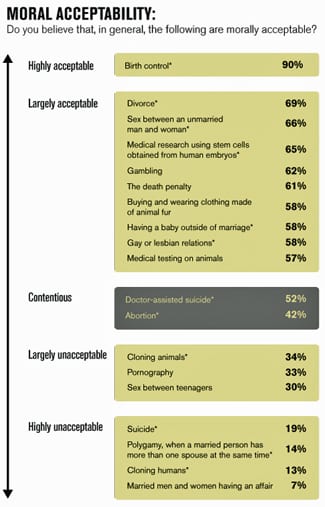BY LISA KEEN
Public opinion on same-sex relations has improved more dramatically than it has on any other controversial issue with strong moral sensibilities, according to data released May 30 by the Gallup Poll organization.
 When asked to indicate, “Do you believe that, in general, the following are morally acceptable?” 58 percent said yes on “gay and lesbian relations.” That's up from 18 points, from 40 percent in 2001, when the question was first asked. (And 40 percent in 2001 wasn't the lowest year for the issue. In 2002, moral acceptability of “gay and lesbian relations” was at 38.)
When asked to indicate, “Do you believe that, in general, the following are morally acceptable?” 58 percent said yes on “gay and lesbian relations.” That's up from 18 points, from 40 percent in 2001, when the question was first asked. (And 40 percent in 2001 wasn't the lowest year for the issue. In 2002, moral acceptability of “gay and lesbian relations” was at 38.)
“The sharp rise in the share of the public viewing [gay and lesbian relations] as morally acceptable is unmatched by any of the other items on the Gallup survey,” said Patrick Egan, a New York University professor of politics who specializes in public opinion and LGBT demographics. “This reflects broader positive movements in American public opinion on gay rights and gay people that we've been seeing over the past two decades.”
Williams Institute Scholar Gary Gates notes that the Gallup findings on moral acceptability are consistent with the Gallup findings last week that 63 percent of Americans support allowing same-sex couples to adopt children and with the recent Gallup poll finding 55 percent support allowing same-sex couples to marry.
“The findings across these three polling questions suggest that Americans' growing support for same-sex relationships and families is not just confined to a sense of moral acceptability, but also translates into increasing support for formal legal equality,” said Gates.
 In the May 30 poll, “gay and lesbian relations” was one of 19 “moral issues” on which respondents were asked to weigh in. Its acceptability level (58 percent) matched that of buying and wearing fur, having a baby outside of marriage, and (at 57 percent) medical testing on animals.
In the May 30 poll, “gay and lesbian relations” was one of 19 “moral issues” on which respondents were asked to weigh in. Its acceptability level (58 percent) matched that of buying and wearing fur, having a baby outside of marriage, and (at 57 percent) medical testing on animals.
The issue that has seen the greatest improvement in public acceptability, after “gay and lesbian relations,” is having a baby outside of marriage. It rose 16 points between 2001 and 2014. Sex between an unmarried man and woman rose 13 points in acceptability.
Of the 19 issues, birth control had the highest acceptability rating (90 percent), followed by divorce (69 percent), and sex between an unmarried man and woman (66 percent).
Married men and women having an affair ranked the lowest of 19 categories at seven percent, followed by cloning humans (13 percent) and polygamy (14 percent).
Public acceptability went down on only four issues: medical testing on animals (eight percent), the death penalty and wearing fur (two percent), and gambling (one percent).
Opinion about abortion went unchanged between 2001 and 2014, with 42 percent of the public saying it was acceptable.
Gallup has been conducting its “Values and Beliefs Poll” every May since 2001. This year's poll was conducted by telephone on a random sample of 1,028 adults in all 50 states plus the District of Columbia. The margin of error is plus-or-minus four percentage points. The sample is weighted to match national demographics.
In the first four years of doing the survey, Gallup asked people about the moral acceptability of “homosexual behavior.” In those years, the response ran between 38 and 44 percent. For three years (2006-2008), it asked about “homosexual relations.” The response ran from 44 to 48 percent.
Beginning in 2009, Gallup asked about “gay and lesbian relations.” The improvement between 2008 (48 percent) and 2009 (49 percent) was only one percentage point.
Egan noted that the term “gay and lesbian relations” is “definitely a vague” one. So some respondents might interpret it as sexual relations and some might interpret it as same-sex relationships.
“My sense is that respondents are interpreting the item as an invitation to render moral judgment on gayness writ large,” he said.
The biggest one-year leap in improvement came in May 2003, when 44 percent of the public said “gay and lesbian relations” were morally acceptable, up six percentage points from the low of 38 percent. The second biggest leap came in May 2013, when it showed a five percent jump over the previous year. (A year after President Obama gave his nationally broadcast interview to ABC's Robin Roberts, expressing his support for same-sex couples being able to marry, and six months after three states approved marriage equality ballot measures.)
May 2013 was the high point in acceptance. Polling this year showed a one-percentage point decrease, to 58 percent. This year's poll was conducted May 8 to 11, just as an Arkansas judge declared that state's ban on same-sex couples marrying to be unconstitutional and national media attention riveted to openly gay National Football League draftee Michael Sam sharing a kiss and hug with his boyfriend.
© 2014 Keen News Service. All rights reserved.



